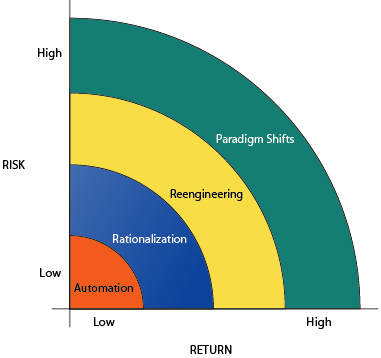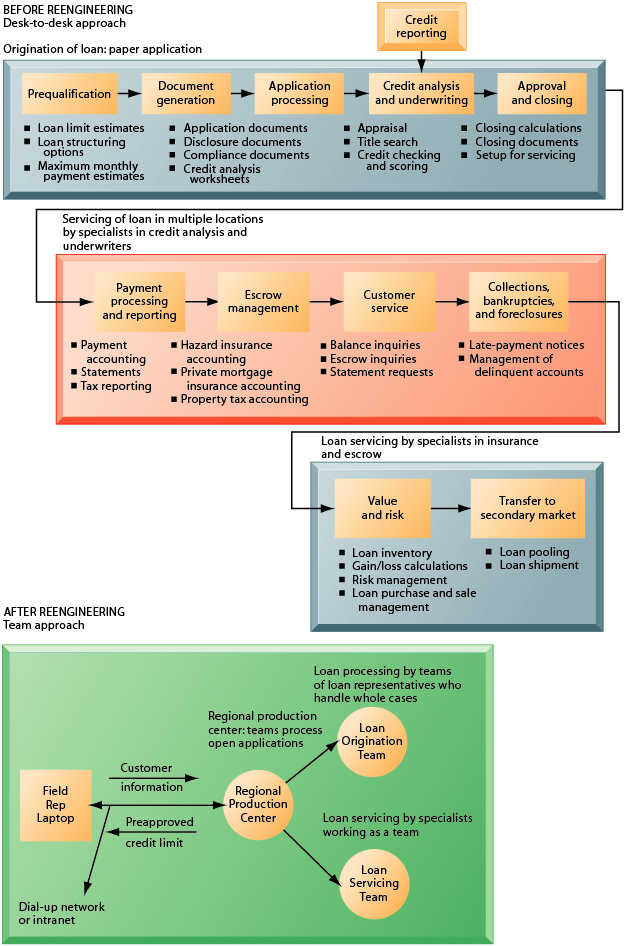| Section 13.1: Bullet Text Study Guide |
Systems as Planned Organizational Change
The process of building a new information system is one kind of planned organizational change. System builders must understand how a system will affect the organization as a whole. They must consider how the nature of work groups will change and how much change is needed.
Four kinds of structural organizational change which are enabled by information technology are:
- Automation: Enables employees to perform their tasks more efficiently and effectively
- Rationalization of procedures: The streamlining of standard operation procedures, eliminating obvious bottlenecks, so that automation can make operating procedures more efficient
- Business process reengineering: Analyzes, simplifieds, and redesigns business processes with a mind to radically reduce business costs
- Paradigm shift: A radical reconceptualization of the nature of the business and the nature of the organization
Figure 13-1
 |
|
Paradigm shifts and re-engineering often fail because extensive organizational change is difficult to orchestrate. However, the rewards of successful paradigm shifts can also be very high.
Business process reengineering involves radical restructuring of business processes before applying information technology to make them more efficient. The mortgage industry has benefited from extensive reengineering of the mortgage application process to replace "desk-to-desk" sequential work on documents with a "work cell" approach in which many people work on the same document simultaneously. Reengineering sometimes uses workflow management software to move documents easily and efficiently between different users and locations.
Figure 13-2
 |
|
Effective reengineering requires understanding which business processes need improvement and how this improvement helps the firm execute its strategy. Identifying the business processes with the highest priority includes performing a strategic analysis and identifying pain points, processes that produce the most complaints.
After identification, the business process itself must be analyzed in terms of its inputs and outputs, flow of products or services, activities, resources, information flow and structure, and process owners, actors, and decision makers.
Further analysis identifies the process costs and time taken to perform the process. Business processes are typically measured along the following dimensions:
- Process cost
- Process time
- Process quality
- Process flexibility
Once a business process is understood, a variety of techniques or principles can be used to improve it, such as:
- Replace sequential steps in the process with parallel steps
- Enrich jobs by enhancing decision authority and concentrating information
- Enable information sharing throughout to all participants
- Eliminate buffers (decision delays and inventories)
- Transform batch processing and decision making into continuous flow
- Processes
- Automate decision tasks where possible
Business process management (BPM) provides a methodology and tools for dealing with the organization's ongoing need to revise its numerous internal and interorganizational business processes.
BPM includes work flow management, business process modeling, quality management, change management, and tools for recasting the firm's business processes into a standardized form where they can be continually manipulated. Process-mapping tools are used to identify and document existing processes and to create models of improved processes that can then be translated into software systems. BPM software tools automatically manage processes across the business, extract data from various sources and databases, and generate transactions in multiple related systems. BPM also includes process monitoring and analytics to verify that process performance has been improved and measure the impact of process changes on key business performance indicators.
Quality management is another area of continuous process improvement. Total quality management (TQM) is a concept that sees quality as a responsibility shared by everyone in the organization. TQM focuses on making a series of continuous process improvements rather than dramatic bursts of change and is considered more incremental than business process reengineering. Six sigma is another quality concept, signifying a quality goal of 3.4 defects per millions of opportunities.
Benchmarking consists of setting strict standards for products, services, and other activities, and then measuring performance against those standards. Companies may use external industry standards, standards set by other companies, internally developed high standards, or some combination of the three.